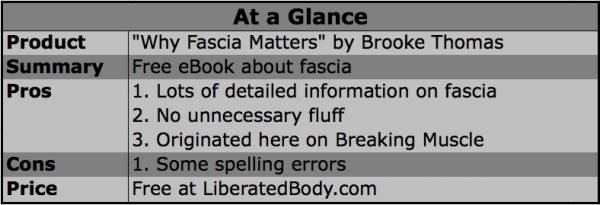
Fascia is one of those topics that everyone needs to know more about, myself included.

Fascia is one of those topics that everyone needs to know more about, myself included.
It’s not easy for the average gym-goer to find high quality information on the body’s connective tissues, but it’s important to know what they do and how they can be kept healthy to keep us pain-free and functioning at an optimal level.
Well, that time to learn more has come with the release of the Why Fascia Matters eBook by Brooke Thomas of Fascia Freedom Fighters. And let me sweeten the deal: the book is free.
Why Fascia Matters actually got its start as an article right here on Breaking Muscle. The article was an instant hit, giving Brooke the push she needed to expand, expound, and adjust the article into this short book. If you thought the article was interesting, wait until you get all the detail on fascia.
While Brooke mentions in the preface of her eBook that it’s is not the end-all guide for fascia, I think it’s got more than enough detail for any average Joe to gain a ton of great information.
This book isn’t long, but it covers a lot of ground, from science and theory, to some useful applications that greatly benefit your life, and even a helpful dose of history.
Learning about scientific topics like these can sometimes prevent people from learning more, but the information is presented in a way that anyone can understand and learn from.

As far as the book itself goes, Brooke is a charming writer. Her style flows nicely and is informal while still being informative.
Writers should take note. Despite her extensive experience on the topic, Brooke comes across as being excited about the material she’s writing about.
It’s no wonder she has developed a great knowledge of human anatomy, because it’s obvious from her writing that Brooke is a lifelong student – exactly the type of person you want to learn from.
The book itself looks nice enough and is easy to navigate. There’s not a lot of fluff in terms of color photos and unnecessarily drawn out descriptions to fill the pages.
The book also has a quite a few spelling and grammatical issues, but it’s par for the course when you’re getting so much information for free, and honestly is no bother whatsoever. What you will learn from the subject matter doesn’t depend on high-precision terms, so it’s no big deal.
The one thing I’d like to see more of from Brooke in the future is an expansion of what we can do on our own to benefit our fascia.
While this is indeed covered in the book, it leaves me wanting more. I look forward to this being expanded further and having a version that actually costs money but covers detailed exercises on how to apply all of the great information.
There’s a big need in our industry for an author of Brooke’s ability and experience to give us the theory and the practice of working on our fascia.
So what are you waiting for? Go get the book!






